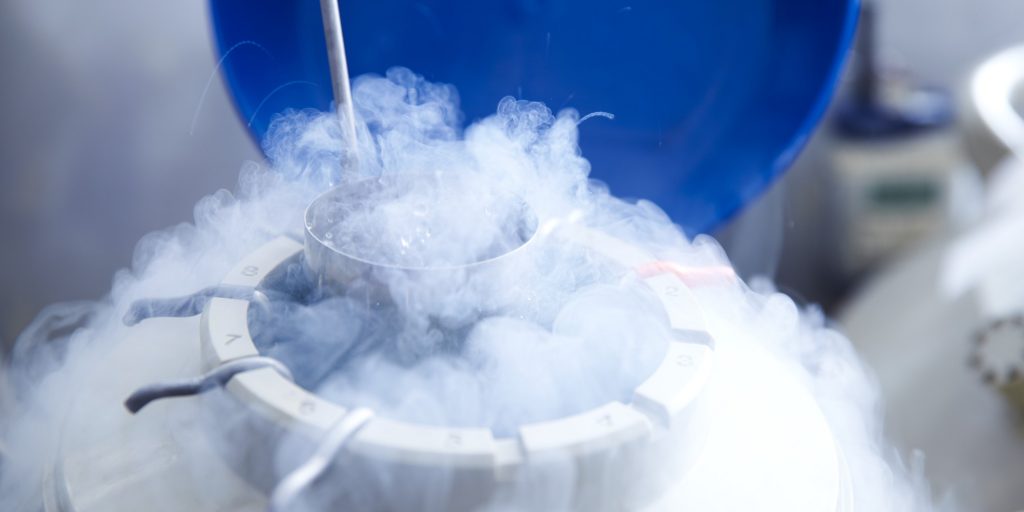Menu
Close
 Semen freezing is the procedure whereby spermatozoa are exposed to cryoprotectants and then cooling them to subzero temperature using liquid nitrogen. Frozen semen samples can be stored for many years while maintaining reasonable parameters of semen. Semen freezing helps in storage, supply or reserve of the human sperm for future use.
Semen freezing is the procedure whereby spermatozoa are exposed to cryoprotectants and then cooling them to subzero temperature using liquid nitrogen. Frozen semen samples can be stored for many years while maintaining reasonable parameters of semen. Semen freezing helps in storage, supply or reserve of the human sperm for future use.
Sperm freezing is widely used and established method in humans and other species, it is very effective in Assisted Reproductive technology (ART) and fertility preservation in patients with cancer, before initiation of radiotherapy or chemotherapy. Semen freezing can be done by two methods 1. Noncontrolled rate cryopreservation and 2. Controlled rate cryopreservation.
CLINICAL APPLICATION OF SPERM FREEZING :-
1.Assisted Reproductive Technologies (ART)
2. Fertility Preservation with Cancer Therapy
3. Non- malignancy systemic diseases and other conditions
4. Surgical procedures involving male genitalia
5. Social and other reasons
ART – Assisted reproductive technologies – IUI/IVF/ICSI:
In ART, the most common use of sperm freezing is in artificial insemination, in vitro fertilization (IVF), or intra cytoplasmic sperm injections (ICSI) for various infertile couples. One of the ART options usually offered to infertile couples is intrauterine insemination using fresh or frozen sperm. Although the technique is used preferably with a fresh semen sample, the availability of freezing sperm samples is an option usually offered by infertility clinics in case the male partner cannot produce semen. In case of severe male factor infertility, the samples can be frozen for later use.
Fertility Preservation with Cancer Therapy:
Another application of sperm freezing is for cancer patients before initiation of cancer therapy. The option of sperm freezing should be offered to any male undergoing chemotherapy or radiotherapy as these treatments can have long-term or permanent cytotoxic side effects on testicular function. One of the advantages of semen freezing is here is that the frozen sperm can stand multiple freezing thawing cycles with no effect on the sperm quality; this is beneficial in cases where patients might have testicular cancer and require surgical removal of the whole testis, with no future possibility of obtaining sperm again. For young males before puberty , cryopreservation of testicular tissue may be an option for fertility preservation in future, improved chemotherapy regimens may give hope to patients in terms of maintaining their sexual and fertility potential after therapy, but at present all male patients diagnosed with cancer who wish to have children should consider sperm freezing or cryopreservation of testicular tissues for further ART use.
Non- malignancy systemic diseases and other conditions:
Cryopreservation of sperm or testicular tissue can also be used in patients prior to cytotoxic therapy for non malignant conditions, such as autoimmune diseases, kidney diseases, inflammatory bowel disease and heart transplant procedures. Most of these conditions are not fatal and the patients should be offered freezing of their sperm or testicular tissue prior to the cytotoxic therapy in order to preserve their fertility for the future.
Surgical procedures involving male genitalia:
Sperm freezing can also be used prophylactically before, during, or after certain surgical procedures as these may have serious adverse effects on male genital structure and functions. An example is the varicocele ligation procedure or reconstructive surgery (e.g. vasovasectomy or vasoepididmostomy). Sperm freezing may also be used postoperatively to insure against subsequent loss of patency of the vas deferens.
Social and other reasons:
Sperm freezing could be a mean of preserving fertility in men with social reasons to preserve their rights to have children bearing their names, for example soldiers being deployed to combat missions in war. Other reasons for sperm freezing might be immediately pre and postmortem where relatives of a person wish to ensure that the person can have a legal heir.
CONCLUSION:
Applications of sperm freezing now days are diverse and include humans, animals and insects. Despite the undeniable morphological and functional adverse effects that cryopreservation exerts on sperm, it still remains one of the core methods of fertility preservation for patients and healthy volunteer donors. Future studies are expected to concentrate on advancing technology to achieve the goal of “damage free” sperm after freezing. Encouragingly, recent advances in ART suggest that it will be possible eventually to achieve a healthy pregnancy and live birth from freezing of a single sperm or frozen semen sample. Nevertheless, it has proved to be boon in the era of modernization helping childless couples to embrace parenthood. Sperm freezing has become an accepted modality for fertility preservation and childless couples.

We offer our patients widest range of infertility technology and our goal is to make your parenting dreams comes true
SAIMS Campus,Indore-Ujjain state highway,Near MR-10 crossing,Indore (M.P.)-453111
Monday
Tuesday
Wednesday
Thursday
Friday
Saturday
09:00-17:00
09:00-17:00
09:00-17:00
09:00-17:00
09:00-17:00
09:00-17:00
WhatsApp us